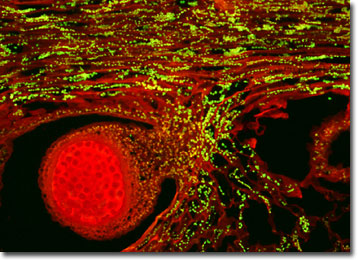Fluorescence Digital Image Gallery
Clubmoss (Lycopodium)
Approximately 200 species of small, creeping plants commonly known as clubmosses belong to the genus Lycopodium. In spite of their common name, however, clubmosses are more closely related to ferns than to the true mosses.

Historically, clubmosses have endured many climatic and environmental changes. The plants were particularly abundant hundreds of millions of years ago during the Paleozoic era, when they grew to massive proportions and dominated the Earth. Today, clubmosses are much smaller and are primarily native to mountains in the tropics, though they may also be found in northern forests. The exact dimensions of the plants are dictated by species, but a typical example is stag’s horn moss (L. clavatum), which features creeping stems about 10 feet long and has approximately 4-inch-high ascending branches.
Similar to ferns, clubmosses exhibit alternate generations, oscillating between an underground sexual phase of the plant and an above ground spore-producing version. The yellowish, powdery spores of the clubmosses have been gathered for human use for many years. They contain a flammable type of pollen that was utilized as flash powder for early photographic cameras and was frequently an ingredient of fireworks. The spores also have a long history of use in medicinal treatments, especially in dusting powders formulated to remedy conditions such as eczema, intertrigo, herpes, and ulcers.
BACK TO THE FLUORESCENCE DIGITAL IMAGE GALLERY
